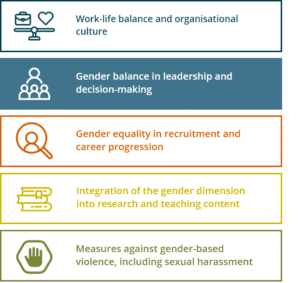Gender equality is a broad and multi-faceted concept. The European Commission recommends a division into five thematic areas for gender equality in research & innovation. In a series of five articles, we will introduce you to these thematic areas, which we like to call Key Areas of Intervention (KAIs). This article will focus on KAI 2: ‘Gender balance in leadership and decision-making’.

”By definition, attainment of SDG5, gender equality, is impossible without women’s representation at the top.”
(IFC, 2023).
SDG target 5.5 ‘Ensure women’s full and effective participation and equal opportunities for leadership at all levels of decision-making in political, economic and public life’ and explicitly points to female representation within different levels of decision-making as a factor to achieving gender equality. It ensures that organisations, parliaments or governments reflect the population they represent. Having everyone involved in decision-making broadens the perspectives, increases creativity and innovation, diversifies the pool of talents and competences, reduces conflicts, and improves the process of decision-making (UNDP, 2020). In addition, women’s representation among boards of directors, corporate executives and workplace managers is associated with less workplace gender segregation and discrimination (Stainback, 2016), indicating that larger percentages of women in leadership positions tend to provide less discriminatory and more supportive environments. Women’s participation in decision-making can therefore contribute to further improve gender equality, benefiting not only women but society as a whole.
However, although efforts to promote gender balance in leadership and decision-making have been undertaken in numerous industries and institutions, data shows that women remain underrepresented in higher management positions across Europe. Globally, women hold only 19.7% of board seats, 15.7% of CFO positions, 6.7% of board chairs and 5% of the CEO positions. (Deloitte, 2022). Additionally, in 2022, 32.6% of senior leadership roles were taken up by women (WEF, 2022), with large discrepancies between industries such as Education (46%), compared to Energy (20%) and Infrastructure (16%). These statistics illustrate the inequalities that still exist and the hurdles that women face in reaching leadership positions.
Hidden barriers in organisational cultures, e.g. social stereotypes and biases, lack of resources and lack of advancement opportunities, are amongst the challenges that women face in securing leadership positions and that undermine their ability to succeed. Achieving gender balance in leadership and decision-making therefore does not only refer to ensuring access to these positions, but also to providing an enabling environment and the necessary tools and resources to succeed.
It is also important to understand that gender balance in decision-making does not always lead to equal decision-making power. It is therefore important to further examine the roles and responsibilities that female board members have in comparison to their male counterparts.
Similarly, having a female CEO as head of an organisation does not always lead to more inclusive decision-making. Therefore, although statistical gender balance is a good place to start, it does not always contribute to more gender equality, making it important to look further than statistics into roles and responsibilities within organisational cultures.
So how can organisations effectively work towards gender balance in leadership and inclusive decision-making? There are some practices that have proven to be successful:
- A gender quota is an instrument aimed at accelerating the achievement of gender-balanced participation by establishing a defined proportion of places to be filled by the underrepresented gender. For example, a quota can require companies to fill a third of their electoral lists with women or 40% of the supervisory board to be women. This is however a contested instrument, involving discussions on the importance of merit and favoritism.
- Increasing the gender balance in hiring and promotion committees reduces biases in the hiring and promotion processes, allowing more balanced decisions to be taken and preventing a replication of the ‘old boy’s network’.
- Offering training programs aimed at unconscious bias and gender sensitivity can help people become more aware of social stereotypes in the organizational culture and prevent biases from impacting decisions in the organisational culture and prevent biases from impacting decisions in the organisation.
UNDP (2020). Women’s participation in decision making: Why it matters.
Stainback, K., Kleiner, S. & Skaggs, S. (2016). Women in power: Undoing or redoing the gendered organization? Gender and Society, 30(1).
Deloitte (2022). Progress at a snail’s pace: women in the boardroom. Deloitte Global Boardroom
Program.
WEF (2022). Global Gender Gap Report 2022. Insight report.
Read more about Diversity, Equity and Inclusion
Budget voor de STOZ- regeling verdubbeld voor 2025
Budget voor de STOZ- regeling verdubbeld voor 2025: de laatste aanvraagronde binnen deze regeling loopt tot 30 september 2025. Voor de Stimuleringsregeling Technologie in Ondersteuning en Zorg (STOZ) is het subsidieplafond verhoogd van € 27 miljoen naar € 54 miljoen...
Subsidie verbetering basisvaardigheden
Taal, rekenen, burgerschap en digitale geletterdheid zijn essentiële basisvaardigheden voor deelname aan de maatschappij. Het blijkt dat Nederlandse jongeren hierin sterk achteruitgaan. Het ministerie van Onderwijs, Cultuur en Wetenschap (OCW) stelt daarom de...
SLIM-subsidie versterkt leercultuur bij V-Tron
De SLIM-subsidie is bedoeld om leren en ontwikkelen binnen het mkb te stimuleren. V-Tron heeft met ondersteuning van Nehem de leercultuur onder zijn medewerkers versterkt. Heeft u plannen om in 2025 de onlangs verlengde SLIM-subsidie aan te vragen voor uw eigen mkb of...


